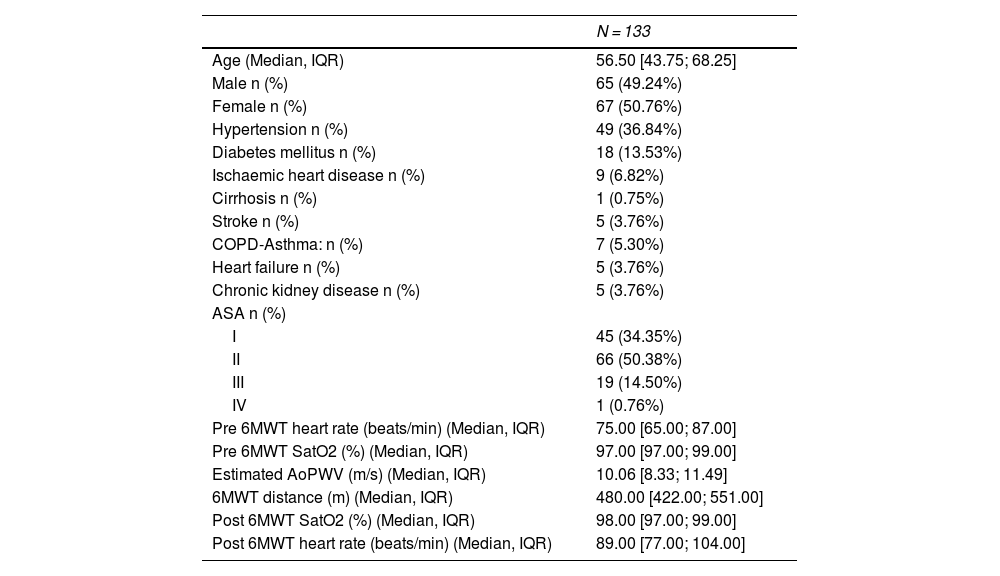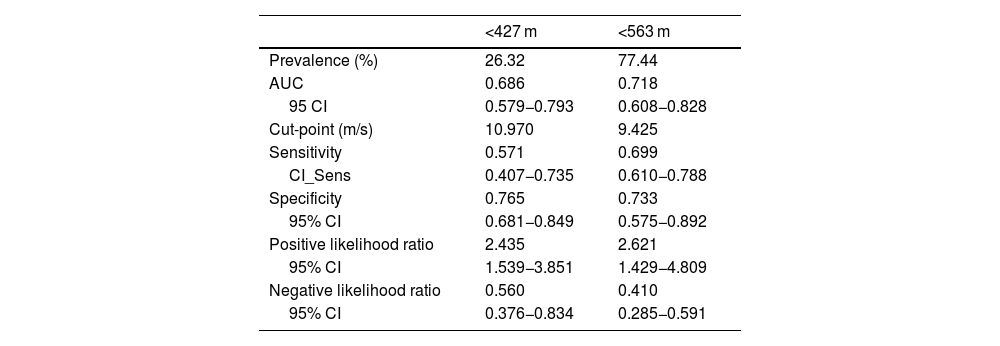This study aimed to assess the efficacy of estimated preoperative aortic pulse wave velocity (AoPWV) to discriminate between low and high 6 min walk test (6MWT) distance in patients awaiting major non-cardiac surgery.
MethodsProspective observational study in 133 patients undergoing non cardiac surgery. AoPWV and the distance walked during a 6MWT were assessed. Receiver operating characteristic (ROC) curve analysis was used to determine two different AoPWV cut-points for predicting a distance of 427 m in the 6MWT. We also calculated lower and upper AoPWV cut-points (probability ≥ 0.75) for predicting a distance of < 427 m, ≥427 m, and also 563 m in the 6MWT.
ResultsThe ROC curve analysis for the < 427 m distance revealed an area under the curve (AUC) of 0.68 (95% confidence interval 0.56–0.79) and an AUC of 0.72 (95% confidence interval 0.61–0.83) for >563 m. Patients with AoPWV > 10.97 m/s should be considered high risk, while those with <9.42 m/s can be considered low risk.
ConclusionsAoPWV is a simple, non-invasive, useful clinical tool for identifying and stratifying patients awaiting major non-cardiac surgery. In situations of clinical uncertainty, additional measures should be taken to assess the risk.
El objetivo de este estudio fue evaluar la eficacia de la velocidad estimada de onda de pulso (VOP) aórtica preoperatoria para discriminar entre la distancia corta y larga de la prueba de caminata de 6 min (6MWT) en los pacientes en espera de cirugía mayor no cardiaca.
MétodosEstudio observacional prospectivo en 133 pacientes sometidos a cirugía no cardiaca. Se evaluaron la VOP aórtica y la distancia recorrida durante una 6MWT. Se utilizó el análisis de la curva ROC (Receiver operating characteristic) para determinar dos puntos de corte diferentes de VOP aórtica para predecir una distancia de 427 m en la 6MWT. También calculamos los puntos de corte inferior y superior de la VOP aórtica (probabilidad ≥ 0,75) para predecir una distancia de < 427 m, ≥ 427 m, y de 563 m en 6MWT.
ResultadosEl análisis de la curva ROC para la distancia de < 427 m reveló un área bajo la curva (ABC) de 0,68 (valor de intervalo de confianza del 95%: 0,56–0,79) y un ABC de 0,72 (valor de intervalo de confianza del 95%: 0,61–0,83) para > 563 m. Los pacientes con VOP aórtica > 10,97 m/s deberán considerarse de alto riesgo, mientras que aquellos con < 9,42 m/s deberán considerarse de bajo riesgo.
ConclusionesLa VOP aórtica es una herramienta simple, no invasiva y útil para identificar y estratificar a los pacientes en espera de cirugía mayor no cardiaca. En situaciones de incertidumbre clínica, deberán adoptarse medidas adicionales para evaluar el riesgo.












